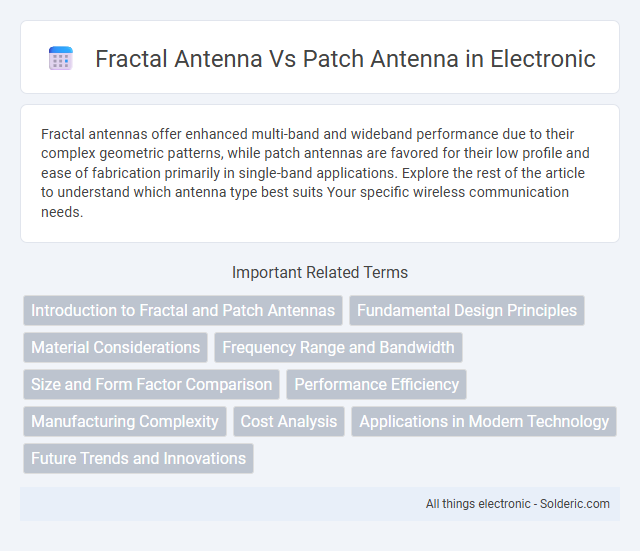Fractal antennas offer enhanced multi-band and wideband performance due to their complex geometric patterns, while patch antennas are favored for their low profile and ease of fabrication primarily in single-band applications. Explore the rest of the article to understand which antenna type best suits Your specific wireless communication needs.
Comparison Table
| Feature | Fractal Antenna | Patch Antenna |
|---|---|---|
| Design | Complex, self-similar fractal geometry | Simple planar rectangular or circular shape |
| Size | Compact, reduced footprint due to fractal pattern | Relatively larger due to wavelength dimensions |
| Frequency Range | Multiband and wideband capable | Typically narrowband or single band |
| Bandwidth | Wide bandwidth performance | Narrow bandwidth |
| Gain | Moderate gain, dependent on fractal iterations | High gain due to resonant cavity |
| Radiation Pattern | Complex, frequency-dependent pattern | Stable, broadside directional pattern |
| Fabrication | More complex due to fractal shapes | Simple and cost-effective |
| Applications | Wireless devices, multiband communication, compact systems | Satellite, radar, mobile devices requiring stable beams |
Introduction to Fractal and Patch Antennas
Fractal antennas utilize self-similar, recursive geometries to achieve compact size and multi-band performance, making them ideal for modern wireless communication systems. In contrast, patch antennas are flat, planar structures typically made of metal on a dielectric substrate, known for their simplicity, low profile, and ease of fabrication, commonly used in GPS and mobile devices. The fundamental difference lies in fractal antennas' complex geometric design optimizing frequency bands versus patch antennas' straightforward resonant structure optimized for specific frequencies.
Fundamental Design Principles
Fractal antennas utilize self-similar, repeating geometric patterns to maximize the effective length within a compact size, enhancing multiband and wideband performance. Patch antennas consist of a flat conductive element over a ground plane, designed primarily for narrowband operation with planar geometry and resonant frequency determined by patch dimensions. Both rely on electromagnetic principles, but fractal antennas exploit fractal geometries for frequency agility, whereas patch antennas focus on simple resonant structures for stability and manufacturability.
Material Considerations
Fractal antennas often use flexible substrates like FR4 or polyimide to support complex geometries that enhance bandwidth and multiband performance, while patch antennas commonly employ rigid dielectric materials such as Rogers RT/duroid for stable resonant frequencies and low loss. The material's dielectric constant and loss tangent critically influence antenna efficiency, with fractal designs benefiting from materials that maintain performance across diverse frequency bands. Thermal stability and mechanical durability are vital for patch antennas in high-power applications, whereas fractal antennas prioritize lightweight and adaptable materials for flexible or conformal installations.
Frequency Range and Bandwidth
Fractal antennas exhibit a wide frequency range and enhanced bandwidth due to their self-similar, recursive geometries, enabling them to operate efficiently across multiple frequency bands. In contrast, patch antennas typically offer narrower bandwidths, limited by their conventional planar design, but provide precise frequency control within specific bands. Your choice between the two depends on whether broad frequency coverage or focused bandwidth performance is more critical for your application.
Size and Form Factor Comparison
Fractal antennas offer a significantly smaller size and more complex geometric shapes compared to traditional patch antennas, enabling enhanced multi-band and wideband performance within limited space. The self-similar, recursive fractal designs reduce the effective resonant length, making fractal antennas ideal for compact wireless devices where space constraints are critical. In contrast, patch antennas typically feature planar, rectangular or circular shapes with larger surface areas, resulting in a bulkier form factor that may limit integration in miniaturized systems.
Performance Efficiency
Fractal antennas exhibit higher performance efficiency due to their self-similar, space-filling design that enables multiband and wideband capabilities with reduced size. Patch antennas typically offer moderate efficiency but are limited by narrow bandwidth and single-frequency operation, impacting their overall performance in complex communication systems. The fractal geometry enhances current distribution, leading to improved radiation efficiency and gain compared to conventional patch antennas.
Manufacturing Complexity
Fractal antennas exhibit higher manufacturing complexity due to their intricate, self-similar geometric patterns that require precision in fabrication processes such as photolithography or advanced milling. In contrast, patch antennas feature simpler, planar designs with straightforward rectangular or circular shapes, making them easier and more cost-effective to produce at scale. Your choice between these antenna types should consider this complexity, as fractal antennas deliver multi-band performance but may increase production time and costs compared to patch antennas.
Cost Analysis
Fractal antennas typically offer cost advantages due to their compact design, which reduces material usage compared to patch antennas, leading to lower manufacturing expenses. Patch antennas often require more precise fabrication techniques and higher-quality substrates, increasing production costs. Understanding your specific application can help determine if the cost savings of fractal antennas justify their performance characteristics.
Applications in Modern Technology
Fractal antennas excel in compact wireless devices and IoT applications due to their multiband and wideband capabilities, enabling efficient signal reception across various frequencies. Patch antennas are widely used in satellite communication, GPS systems, and mobile devices, offering low-profile design and ease of integration on printed circuit boards. Both antenna types support advancements in 5G networks, UAV communications, and wearable technology, meeting the demand for miniaturization and high-performance connectivity.
Future Trends and Innovations
Fractal antennas offer significant advantages in miniaturization and multi-band capabilities, driving future trends in compact and flexible wireless devices. Emerging innovations leverage fractal geometry to enhance signal bandwidth and improve efficiency in 5G and IoT applications. In contrast, patch antennas continue evolving with advanced materials and integration techniques to support high-frequency communication and conformal design requirements.
fractal antenna vs patch antenna Infographic

 solderic.com
solderic.com